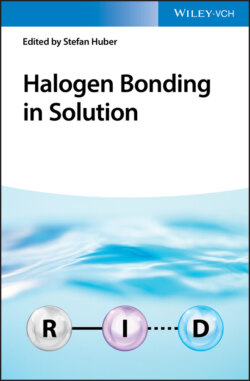Читать книгу Halogen Bonding in Solution - Группа авторов - Страница 19
1.2.1 Rediscovery
ОглавлениеDihalogens contributed extensively to the early identification of the halogen bond interaction. However, diatomic halogens (and interhalogens) limit the possible functional applications because they tend to be reactive and offer little in the way of tunability. This has led to the extensive study of haloorganics since the mid‐1980s, as these species are readily adaptable to systematic study. For example, Weiss described interesting early instances of organic and cationic halogen donor complexes [53–55]. Additionally, a team from Politecnico di Milano in Italy, led by Pierangelo Metrangolo and Giuseppe Resnati, have studied many different haloorganics, including haloperfluorocarbons. Their contributions have aided in stimulating interest in halogen bonding. In particular, a review paper [56] and concept article [57] compile much of their early works and largely unify the field. The paper that many cite as the “rediscovery” of halogen bonding is titled “Halogen bonding: A Paradigm in Supramolecular Chemistry.” Here, Metrangolo and Resnati describe several halogen bonding concepts that remain topical today such as hydrogen and halogen bonding selectivity, donor selectivity, acceptor selectivity, hard–soft acid–base favorability, the ability of the halogen bond to outcompete the hydrogen bond, and the ability of the halogen bond to perform admirably in aqueous media. This unification of halogen bond topics also details various methods for quantifying and identifying halogen bond interactions, including the use of heteronuclear NMR resonances (e.g. 14N and 19F). Lastly, they highlight several crystallographic studies providing the groundwork for the surge in subsequent solid‐state halogen bonding studies. The design principles outlined by Metrangolo and Resnati highlight advantageous features of the halogen bond for the construction of predictable supramolecular architectures. For example, the effectiveness of dihalogen perfluorocarbons paired with various di‐Lewis basic molecules to engender the formation of linear one‐dimensional (1D) chains (Figure 1.5). Taken together, the studies from the groups of Metrangolo and Resnati have been instrumental in making the halogen bond topical to so many diverse research areas.
Figure 1.5 ChemDraw figure highlighting the use of alkyl‐ and aryl‐dihaloperfluorocarbon halogen bond donors to form predictable 1D networks in the solid state.
Source: From Metrangolo and Resnati [57]. © 2001 John Wiley & Sons.
